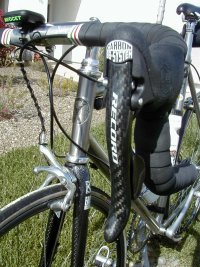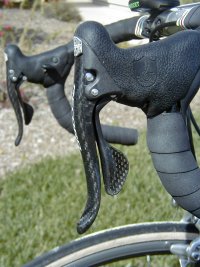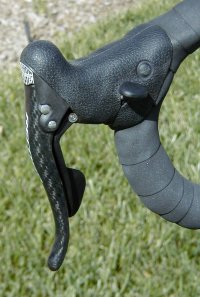| Campagnolo's new carbon Ergo levers, introduced this
year for the Record Gruppo, have caused quite a stir
among Campy fans. Unique and high-tech, the levers have
added a unique element to Campagnolo's top-of-the-line
gruppo. However, we here at Campagnolo Only have begun
to hear rumors of poor performance from some who have
used the levers. Some riders have questioned whether
Campagnolo has pushed the envelope of performance too far
this time.
With these questions in mind, we asked Campagnolo to
send us a pair of the new levers to test and evaluate.
They agreed to send them, and here are the results:
The Road Test
Begins
 Added March 28th--Photos
Added March 28th--Photos

As promised, the levers have arrived from
Campagnolo--about a week ago (March 18th). We promptly
installed them, replacing a set of 1997 Chorus 9-speed
levers (leaving the rest of the drivetrain intact). Here
are some first impressions after about 200 miles of
riding:
- You'll know these levers are different from the
moment you open the box--there's a strong
chemical odor (from the resin in the brake
levers, probably) that is unlike any other
Campagnolo product. It took a day or so for the
levers to fully "air out" and lose that
strong odor.
- Visually, the levers are very striking (watch for
photos of our test set soon). The brake levers,
shift levers, lever bodies, and brake hoods are
all black--we combined them with black handlebar
tape for a neat "stealth" look. There
is nothing like them in the peloton. See photos
- Minor point--the shift levers, while they are
"carbon," are in fact injection-molded
of a combination of carbon fibers and resin. The
surface of the shift lever (the part that faces
out) is inset with what appears to be either a
thin layer of woven carbon fiber (like the
surface of the brake levers or a carbon-fiber
fork) or a decal that looks like carbon fiber.
The shift levers are very thin--about half as
think as their aluminum counterparts--and the
trailing edge (facing the handlebars) is almost
sharp. We had to relearn our habit of wrapping
fingers around the back of the shift lever, as
the thin edge made that uncomfortable.
- Installing the levers was very straighforward.
There's nothing different about installing the
carbon version, although you'll probably want to
be a little more delicate than usual to avoid
scratching the clear coat on the brake levers. Note:
Expect some hassle getting them on the bars. The
bolt that protrudes from the mounting clamp is
about 2 mm shorter than the same piece on my
Chorus levers. You need to back off on the bolt
that holds the body and the clamp together to
slide the levers onto the bars, but it's very
tough not to have the bolt come completely
undone. And when it does, it's quite hard to get
on again. A little more length in the bolt would
add a fraction of a gram to the assembly, but
would be very welcome.
- Once on the bike, the levers were easy to set up.
Dialing in the indexing took only a few minutes
on the workstand and a couple of fine-tunes on
the road.
- How do they work? We are told by
others that the levers take a few hundred miles
to "break in," after which they work
better than the '98 version. Our experience thus
far is that the left-hand lever works much better
than our time-tested Chorus levers, even
brand-new. Shifts to the larger chainring are
easier, and downshifts to the small ring work
great, too. On the right-hand side, shifts to
smaller cogs are amazingly smooth. The action is
much smoother than what we are used to. Shifting
to larger cogs works OK, but the
"clicks" are a bit on the stiff side,
and the lever occasionally needs to be held for a
1/2-second longer than usual until the chain
moves over. They're getting better, but at this
point are still not up to the Chorus levers. Note:
Rumors to the contrary aside, these levers are
definitely being used in the European peloton.
Check out the March issue of VeloNews, and you'll
see quite a few photos of riders using the
levers, including the Het Volk classic being won
by Frank Vandenbroucke on a Campy-equipped bike.
- Are they worth it? In other
words, "Do I need these levers?" At
this point, hard to say. At about $300, these may
be most expensive shift levers on the
planet--it's quite possible to buy a very
serviceable entire bike for what you'll
fork out to first on your block with these
shifters. If you're a weight freak, you'll be
pleased to know that they are very light--about
three ounces lighter than the Chorus levers they
replaced (we measured the carbon version at 7.2
ounces for the pair). That's a pretty amazing
weight loss in an already light component, but
it's hard to say that a 23-gram drop in weight
from last year's Record levers is going to make
the difference between winning and losing a race.
Check your bank account, then decide--as Tim
Laflin says in his review of this year's gruppos,
Chorus is hands-down a better value, but for
those who must have the best, Record is there.
- Other thoughts--Just one so far:
Don't crash with these levers! Strong as
they are, those carbon levers sure look like they
would be badly scarred in a battle with the
pavement.
- A few photos--Presented below
are a few photos of the new
levers:
 |
|
 |
| Photo above:
Front view of the new levers. The
"Record" lettering is underneath the
clear coat over the top of carbon weave. In the
background, our test platform, a Merlin Ti road bike. |
|
Photo above:
The shift levers are injection-molded carbon
fiber; the weave insert is placed where your
fingers touch the levers. |
| |
|
|
 |
|
 |
| Photo left:
The inner side of the levers. The shape of the
levers and the body of the levers is the same as
the '98 aluminum version. |
|
Photo right:
The levers are "computer-ready"--each
has a small button on the hood covers, with a
cavity beneath the button for future mounting of
Campy's upcoming integrated cyclocomputer. The
left lever's button will operate the start/stop
function; the right (shown above) will change
mode. |
|
